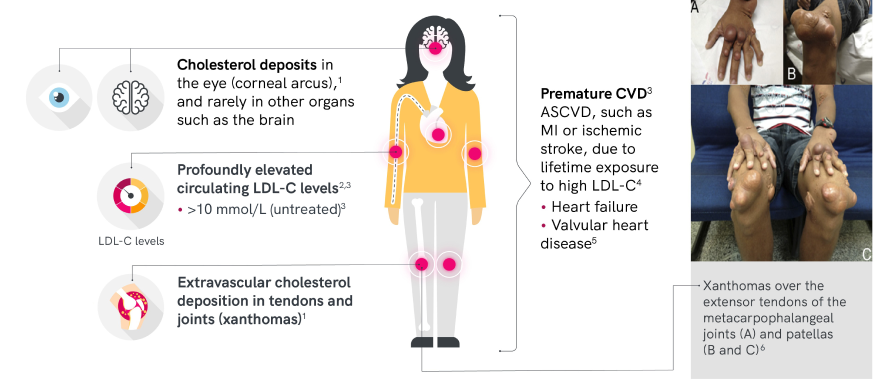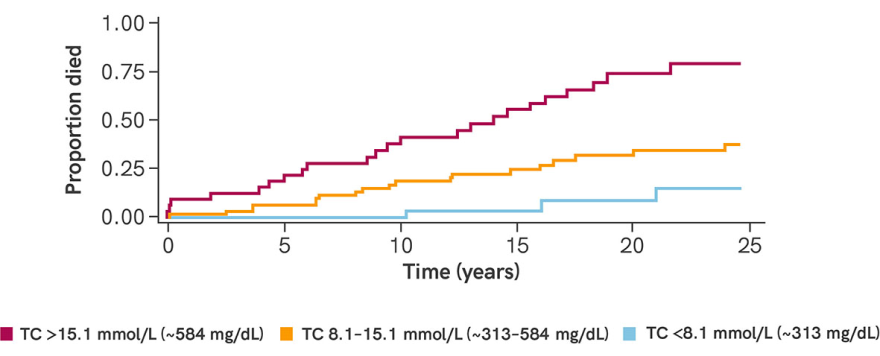The clinical presentation of HoFH is variable and important to diagnose early

Both children and adults can present with a combination of the following signs according to the severity of the phenotype

ASCVD, atherosclerotic cardiovascular disease; CVD, cardiovascular disease; MI, myocardial infarction.
2023 ESC/EAS Diagnostic Criteria
- HoFH can be diagnosed using clinical and/or genotypic criteria recommended by the EAS Guidelines3
- HoFH should be suspected if untreated LDL-C levels are >10 mmol/L (> 400 mg/dL), requiring further evaluation, including a detailed medical and family history and/or genetic testing3
| Clinical diagnostic criteria | Genotypic diagnostic criteria | |
|---|---|---|
| LDL-C >10 mmol/L* |
Cutaneous or tendon xanthomas before age 10 years and/or Untreated elevated LDL-C levels consistent with HeFH in both parents** |
Confirmation of two pathogenic variants in the LDLR, APOB, PCSK9, or LDLRAP1 genes† |
LDLRAP1 = low-density lipoprotein receptor adapter protein 1
*Lower LDL-C levels, especially in children or in treated patients, can be seen in genetically confirmed HoFH
**In digenic form, one parent may have normal LDL-C levels and the other may have LDL-C levels consistent with HoFH
†Bi-allelic pathogenic/likely pathogenic variants on different chromosomes at the LDLR, APOB, PCSK9, or LDLRAP1 genes or >2 such variants at different loci
While genetic testing may aid diagnosis, HoFH may be present in patients without known FH-related mutations7
Genetic testing is useful for risk stratification and, in the case of LDLR-deficient patients, may predict poor response to drug treatment1
Importance of Early and Accurate Diagnosis
HoFH is underdiagnosed and undertreated in the general population8,9
- Lack of awareness of HoFH among physicians10
- Many cases are not diagnosed in childhood, when atherosclerosis may be preventable11
- A significant proportion of patients are misdiagnosed following initial presentation, with HoFH often mistaken for HeFH3,12
The extent and duration of elevated total cholesterol, 90% of which is LDL-C in patients with HoFH, is generally proportional to the severity of atherosclerosis and all-cause and cardiovascular mortality, highlighting the need for prompt diagnosis and treatment initiation13
Increasing risk of all-cause mortality with higher cholesterol level (on-treatment)13*

TC, total cholesterol.
*Retrospective survey of lipid levels and clinical outcomes of 133 HoFH patients treated with a combination of lipid lowering measures between 1990 and 2014 in South Africa and the UK
References
1. France M et al. Atherosclerosis. 2016;255:128–139; 2. Brunham L, et al. 3. Cuchel M et al. Eur Heart J. 2023;00:1–15; 4. Santos RD et al. Lancet Diabetes Endocrinol. 2016;4:850–861; 5. Fahed AC et al. Cholesterol. 2017;2017:3685265; 6. Rocha VZ et al. J Am Coll Cardiol. 2013;61:2193; 7. Ito MK, Watts GF. Drugs. 2015;75:1715–1724; 8. Nordestgaard BG et al. Eur Heart J. 2013;34:3478–3490; 9. Baum SJ et al. J Clin Lipidol. 2014:542–549; 10. Bouhairie VE, Goldberg AC. Cardiol Clin. 2015;33:169–179; 11. Alonso R et al. J Clin Lipidol. 2016;10:953–961; 12. Hemphill L et al. J Gen Intern Med. 2020 35:2225-7; 13. Thompson GR et al. Eur Heart J. 2018;39:1162–1168.